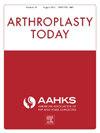非骨水泥全膝关节置换术呈上升趋势。密歇根关节置换术注册合作质量倡议的患者人口统计学和短期疗效报告
IF 1.5
Q3 ORTHOPEDICS
引用次数: 0
摘要
背景骨水泥全膝关节置换术(TKA)是治疗骨关节炎的金标准,但非骨水泥TKA具有改善骨结合和减少骨水泥碎片并发症等优点。本研究旨在调查:(1)从 2017 年到 2021 年,非骨水泥 TKA 是否有所增加;(2)骨水泥和非骨水泥 TKA 的早期并发症是否存在差异。方法对密歇根关节成形术注册协作质量倡议数据库中 6 家医院 2017 年到 2021 年的 TKA 患者进行了回顾性数据回顾。不包括翻修或部分膝关节置换术患者。患者分为两组:非骨水泥固定组和骨水泥固定组。收集了混合固定和反向混合固定的发病率数据,但未收集人口统计学或并发症数据。结果 一项对18749例初次TKA进行的回顾性研究发现,89.7%的患者为骨水泥固定,9.7%为非骨水泥固定,0.7%为混合或反向混合固定。与骨水泥固定的患者相比,非骨水泥固定的患者更年轻、男性、体重更大、目前吸烟且患有糖尿病(P < .0001, P = .03)。他们的住院时间也较短(P ≤ .0001),术前服用的药物也较少:抗凝药物(P = .0059)、抗血小板药物(P ≤ .0001)、阿片类药物(P = .0091)和类固醇药物(P = .0039)。非骨水泥TKA的比例从3.3%上升到17.1%,而骨水泥TKA的比例从96.2%下降到81.9%(P = .0048)。骨水泥TKA的再入院率(4.0%)高于非骨水泥TKA(2.6%)(P = .0048)。结论非骨水泥TKA的使用率从2017年的3.3%增至2021年的17.1%,而骨水泥固定的使用率从96.7%降至81.9%。两组患者的短期并发症无明显差异。非骨水泥固定患者更年轻、更男性、服药更少、住院时间更短、再次入院的可能性更低。不过,与骨水泥组相比,他们更有可能患有合并症。本文章由计算机程序翻译,如有差异,请以英文原文为准。
Uncemented Total Knee Arthroplasty is on the Rise. A Report of Patient Demographics and Short-Term Outcomes From the Michigan Arthroplasty Registry Collaborative Quality Initiative
Background
Cemented total knee arthroplasty (TKA) is the gold standard treatment for osteoarthritis, but uncemented TKA offers benefits like improved osseointegration and reduced complications from cement debris. This study aimed to investigate (1) if there has been a rise in uncemented TKA from 2017 to 2021 and (2) if there are differences in early complications between cemented and uncemented TKA.
Methods
A retrospective data review was performed on the Michigan Arthroplasty Registry Collaborative Quality Initiative database of TKA patients from 2017 to 2021 at 6 hospitals. Patients with revision or partial knee arthroplasty were excluded. Patients were divided into 2 groups: uncemented and cemented. Hybrid and reverse hybrid fixation data were collected for incidence, but not for demographics or complications. All patient demographics and 90-day postoperative events were collected and analyzed.
Results
A retrospective study of 18,749 primary TKAs found that 89.7% were cemented, 9.7% uncemented, and 0.7% hybrid or reverse hybrid. Uncemented patients were younger, men, heavier, current smokers, and diabetics than cemented patients (P < .0001, P = .03). They also had a shorter length of stay (P ≤ .0001) and were on fewer preoperative medications: anticoagulants (P = .0059), antiplatelets (P ≤ .0001), opioids (P = .0091), and steroids (P = .0039). The rate of uncemented TKA increased from 3.3% to 17.1%, while the rate of cemented TKA fell from 96.2% to 81.9% (P = .0048). The readmission rate was higher in cemented TKAs (4.0%) than in uncemented TKAs (2.6%) (P = .0048).
Conclusions
The use of uncemented TKA increased from 3.3% in 2017 to 17.1% in 2021, while cemented fixation decreased from 96.7% to 81.9%. There were no significant differences in short-term complications between groups. Uncemented patients were younger, men, took fewer medications, had a shorter length of stay, and were less likely to be readmitted. However, they were more likely to have comorbidities than the cemented group.
求助全文
通过发布文献求助,成功后即可免费获取论文全文。
去求助
来源期刊

Arthroplasty Today
Medicine-Surgery
CiteScore
2.90
自引率
0.00%
发文量
258
审稿时长
40 weeks
期刊介绍:
Arthroplasty Today is a companion journal to the Journal of Arthroplasty. The journal Arthroplasty Today brings together the clinical and scientific foundations for joint replacement of the hip and knee in an open-access, online format. Arthroplasty Today solicits manuscripts of the highest quality from all areas of scientific endeavor that relate to joint replacement or the treatment of its complications, including those dealing with patient outcomes, economic and policy issues, prosthetic design, biomechanics, biomaterials, and biologic response to arthroplasty. The journal focuses on case reports. It is the purpose of Arthroplasty Today to present material to practicing orthopaedic surgeons that will keep them abreast of developments in the field, prove useful in the care of patients, and aid in understanding the scientific foundation of this subspecialty area of joint replacement. The international members of the Editorial Board provide a worldwide perspective for the journal''s area of interest. Their participation ensures that each issue of Arthroplasty Today provides the reader with timely, peer-reviewed articles of the highest quality.
 求助内容:
求助内容: 应助结果提醒方式:
应助结果提醒方式:


